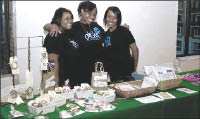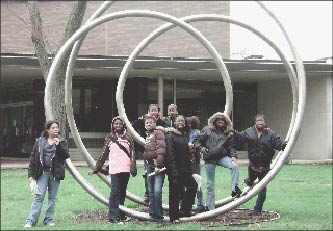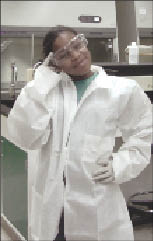Numerous programs address how to keep at-risk students in high school and ensure that they graduate, but there are far fewer concrete pathways for getting at-risk youths into college and making sure they have the academic and personal support they need to remain there. Even fewer programs focus specifically on girls, who, in some ways – teen pregnancy, for example – face greater risks than boys.
Anne Stanton, youth program director at the James Irvine Foundation in San Francisco, says she believes the nation’s educational system is failing in getting at-risk youth to consider post-secondary education and in making sure they are prepared for the transition. The Irvine Foundation recently instituted a new program called ConnectEd: The California Center for College and Career, which is designed to establish a network of schools across nine state school districts that will focus on integrated education to help prepare youth for life after high school graduation.
“Tying education to career is critically important,” Stanton says. “How does what kids are learning relate to their aspirations?” She thinks classrooms need to put more focus on teaching youth how to ask questions, how to work in teams, and how their academics relate to the world’s industries. ConnectEd is a brand-new program, envisioned to work on a grand scale, inside school classrooms.
But a few promising local programs have paved the way for reaching at-risk girls, ensuring that they are aware of how post-secondary education can change their lives and also ensuring that they have the resources to pursue and finish that education. “These are gems for the young people who are in them,” Stanton says. “The question is, can you do this at a system level?”
How to find candidates
Most organizations that help prepare at-risk girls for college rely on an intensive application process to find promising candidates. Girls’ Empowerment Mission (GEM) in Baltimore, which accepts just 14 new recruits a year, relies on school faculty to nominate girls. Once nominated, the girls themselves have to submit an application with teacher recommendations and be interviewed by GEM staff. “We look for girls with the spark to achieve,” says GEM’s founder and director Debbi Weinberg. “And they have to be willing to commit to 100 percent attendance.”
REACH, a relatively new college mentoring program based out of Miami University in Oxford, Ohio, has partnered with the Cincinnati Metro Housing Authority (CMHA), which identifies girls in need of mentoring. The girls, whose grades must be below average, have to apply for the program, supply teacher recommendations and obtain parental consent to participate.
What works
Weinberg says that when working with at-risk girls, it’s important to provide them “drama-free” zones where they can focus on personal development and goal setting and achievement. That means getting them out of the schools, neighborhoods and family settings where young women in poor socioeconomic conditions often feel a lot of pressure. To help, GEM holds monthly weekend retreats for its participants.
The students in GEM also make regular field trips to area colleges to become familiar with the college lifestyle.
GO-GIRL, a college exposure program for seventh-grade girls based at Wayne State University (WSU) in Detroit, focuses on getting girls interested in pursuing math and the sciences. All of its program workshops take place on the Wayne State campus. “They’re in the classrooms, using facilities, using the library, and exploring the labs,” says Sally K. Roberts, assistant professor of mathematics education at WSU and co-founder of GO-GIRL. “We try to immerse them in college life, and we hope they have a good picture of what college life is like.”
Gwendolyn Etter-Lewis, founder of Miami University’s REACH program, believes connecting teen girls with female mentors who are college students is a major key to her program’s effectiveness. “The high school and college students … establish strong rapport with one another. These college students really care about these girls.”
GO-GIRL and REACH provide nuts-and-bolts help with college and financial aid applications.
Ensuring long-term impacts
Getting at-risk girls into college is only the first step. They also need support to ensure they stay there, and many college prep programs aren’t well-equipped for long-term follow-up. Roberts recognized lack of follow-up as a weakness of GO-GIRL, so last fall, with the help of a grant from the RGK Foundation, she initiated GO-GIRL’s first alumnae reunion, as part of GO-GIRL’s new Operation Keeping in Touch initiative. The reunion drew 100 alumnae. The program has also started holding once-a-semester workshops for alumnae on science careers and technology.
Weinberg says GEM is also actively working on college follow-through.
“We know that 85 percent of first-generation college students drop out, so continuing to work with our alumnae is key,” she says.
GEM holds three alumnae events each year; the organization also awards scholarships to help girls enrolled in college meet the costs of their education. The group encourages GEM mentors to stay in touch with their mentees after high school. “You need to be prepared to spoon-feed these girls,” says Weinberg. “They’re not going to get that support at home.”
Girls’ Empowerment Mission (GEM)
Baltimore
(410) 685-0295
http://www.gemmaryland.org
The Strategy: Provide three years of ongoing college prep-oriented support through workshops, retreats and mentoring to girls who are socially and economically at risk.
Getting Started: Girls’ Empowerment Mission (GEM) began six years ago at Chesapeake High School in Baltimore County, when guidance counselor and program founder Debbi Weinberg, who was working with Maryland’s Tomorrow, Baltimore County’s dropout prevention program, decided that in-school counseling was not enough for at-risk young women who had the potential to pursue post-secondary education.
 |
|
Selling handmade pins at annual fundraiser, BeDazzle
|
How It Works: Girls join GEM in the spring of their freshman year in high school and stay with the program through graduation. The girls meet twice monthly on weekday evenings, and then participate in one weekend retreat each month. The meetings and retreats include workshops on developing leadership skills, team building, giving back to one’s community, applying for college and filling out FAFSA (Free Application for Federal Student Aid) paperwork.
The girls also take regular field trips to area college campuses, including the University of Maryland, Johns Hopkins University and Goucher College, to familiarize them with the college lifestyle and to get them excited about post-secondary education. They also gain cultural and lifestyle exposure by attending theater performances, visiting area museums, going to restaurants and participating in outdoor activities like hiking and camping. Each girl is also paired with an adult female mentor, who ideally will follow her through the whole program and into college.
Youths Served: GEM serves 42 girls at a time, with each new class numbering 14. Weinberg says 98 percent of participants are on free or reduced-cost lunch programs, and more than 90 percent are African-American, though there are some Hispanic, Asian, and Caucasian participants. Almost all GEM girls are or will be first-generation college students.
Staff: Weinberg is GEM’s founder and director, and she works without pay. GEM supports two paid part-time leaders for each of the three groups of 14 girls operating each year. Adult mentors, who meet with girls twice a month and talk with them on the phone weekly, are volunteers.
Money: The program’s annual budget is $175,000. GEM is funded entirely by private foundations, including the Dresher Foundation, Baltimore Women’s Giving Circle, Jewish Women’s Giving Foundation and Charles Crane Family Foundation. The program’s initial funding came from the Harry and Jeanette Weinberg Foundation.
Results: The GEM program has a 90 percent retention rate. And Weinberg says GEM has had a 98 percent success rate getting its graduates into college or other secondary education. Of the girls who have graduated from GEM, 80 percent are enrolled in college – of those, 31 percent attend community colleges, 56 percent attend four-year colleges and the remainder attend other forms of higher education, including culinary school. The oldest alumnae are college juniors.
GO-GIRL
Wayne State University
 |
|
Girls spend time on the Wayne State campus …
Photo: Jennifer Lawson |
Detroit
(313) 577-0991
http://www.gogirls.wayne.edu
The Strategy: Expose seventh-grade girls to the college lifestyle as well as college learning, including instruction in the scientific method and team research, in an effort to encourage more girls to study math and science and pursue post-secondary education.
Getting Started: GO-GIRL (Gaining Options-Girls Investigate Real Life) began in 2001 as part of a Research on Gender in Science and Engineering grant from the National Science Foundation (NSF). The initial project was a collaboration between Wayne State University and the University of Michigan to address girls’ confidence in mathematics, focusing on seventh-graders, because that’s when young women are choosing high school coursework.
Wayne State University sponsors the current program under the leadership of GO-GIRL co-founder and Wayne State assistant professor Sally K. Roberts.
How It Works: Girls accepted into the program participate in five hours of on-
 |
|
… and in the labs.
Photo: Jennifer Lawson |
campus programming for 10 Saturdays over the course of an academic semester. The girls are assigned to one of six to nine teams, each of which has one or two supervising mentors, and each team conducts surveys on a research topic of its choice.
A recent study subject was attitudes about dating, in which girls surveyed peers, family members, neighbors and friends about when it’s appropriate for teens to date and how much pressure they feel to date within certain age groups. At the end of the GO-GIRL semester, girls present their research to a gathering of family and friends before their GO-GIRL graduation ceremony.
In developing their research projects, girls learn the scientific method by developing a question, creating a survey designed to answer the question, analyzing data and then reaching a conclusion, with potential caveats. “It fast forwards them in skills they’ll need to use later on in their educational careers,” says Roberts. While conducting their projects, girls use Wayne State University classrooms, libraries and labs, and work with WSU student mentors.
Youth Served: GO-GIRL has served more than 450 girls since its inception. Its oldest graduates are now sophomores in college. The program serves about 60 girls each semester, most of them African-American. Last semester, the girls came from 57 different middle schools, with 25 percent from Detroit Public Schools.
The program is not geared specifically to girls traditionally defined as at-risk, though many of its participants are. “Most of these girls see themselves going to college,” Roberts says. “We didn’t want to isolate kids from more challenging socioeconomic situations from those in, say, suburban neighborhoods.” The result, according to Roberts, is a diverse mix of participants who have been taken out of their traditional comfort zones.
Staff: Roberts runs the GO-GIRL program as a volunteer faculty adviser and is helped by one student assistant, one volunteer graduate student, and two adjunct faculty supervisors. The 12 mentors are all university students.
Money: GO-GIRL operates on an annual budget of $20,000 to $30,000. The National Science Foundation (NSF) provided the program’s initial funding; subsequent funders have included the RGK Foundation, Michigan Department of Education, Wayne State University College of Education and Wayne State University President’s Fund.
Results: The attrition rate for the program is a low 5 percent. There are no longitudinal studies; success reports are mainly anecdotal. Roberts says five alumnae of the program are enrolled at Wayne State University.
REACH
Miami University
Oxford, Ohio
(513) 529-5221
The Strategy: Encourage at-risk teen girls who are residents of a community housing project to consider post-secondary education and other post-graduation opportunities.
Getting Started: REACH (Reaching Every Aspiration for College) began in 2007 as part of the Black Feminist Theory class of Gwendolyn Etter-Lewis, Miami University professor of English, black world studies and women’s studies. Etter-Lewis’ goal was to have her college students emulate the community service work of many of the women they were studying in the class. In cooperation with the Cincinnati Metro Housing Authority (CMHA), the class teamed college-age mentors from Etter-Lewis’ class and teen girls in Cincinnati’s public housing projects. The program outlived the one-semester class and continues to operate under Etter-Lewis’ supervision.
How It Works: Each semester, REACH offers a six- to nine-week session with eighth-grade to 11th-grade girls from area housing projects, where they meet weekly after school from 4 p.m. to 7 p.m. College mentors assist the girls in developing their writing skills and identifying post-secondary schools they’d like to attend, career interests and financial aid opportunities, while also providing homework and academic support.
Etter-Lewis says the college mentors actually develop the program each semester and have included such activities as vocabulary exercises, writing prompts, discussions of popular song lyrics and community service projects. These are designed to engage the girls and help prepare them for the higher expectations and larger world outside their high schools and housing projects. The girls also visit the college campus and participate in sleepovers there.
Youth Served: REACH serves 15 girls a year from eighth to 11th grade. All are residents of Cincinnati housing projects, and all have below average grade-point averages when they enter the program. The program is designed to help them through high school graduation, but most of the girls stick with it for about two years. Current participants are all African-American girls on free or reduced lunch programs; most are from single-parent homes.
Staff: Etter-Lewis is the program’s only regular “staff” member, and her work is voluntary. The program recruits about 10 mentors each year, all of them Miami University students.
Money: Etter-Lewis says she operates REACH on about $5,000 a year, with most of the funding coming from donations from various academic departments at Miami University. Etter-Lewis also covers expenses out of her own pocket and relies on some assistance from the housing authority.
Results: To date, REACH has not conducted any longitudinal studies on its impact, though Etter-Lewis says project partner Harmony Garden, a nonprofit community research group focused on the health and well-being of girls in Cincinnati, has started collecting outcome data this year, with the hope of providing better tracking of girls once they exit the program.
Last year, REACH’s first seniors graduated from high school. Of that first class of 15, two went to college, and one has found a job. Etter-Lewis says she will have six graduating seniors this year and expects two to go to a four-year college, two to a junior college, and one to beauty school. She says the retention rate in the program is about 85 percent.

































